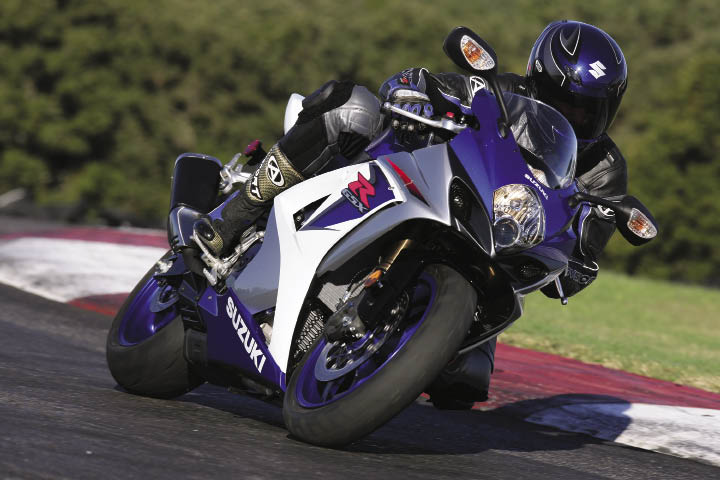Stop it Right There!
Ever since the year 2000, motorcycle technology has been on a rapid incline. First, we enjoyed the benefits of fuel injection, allowing a motorcycle’s engine to run perfectly regardless of the environment. Then along came radial mount brakes, which dramatically increased the  stopping power and feel, and now we are seeing the introduction of traction control systems on some of the larger displacement sport bikes, assisting today’s rider in controlling the massive power output that is available in these machines.
stopping power and feel, and now we are seeing the introduction of traction control systems on some of the larger displacement sport bikes, assisting today’s rider in controlling the massive power output that is available in these machines.
For the past four years I have been hosting track promotions with Suzuki Canada and its Alberta dealers, where their clients who purchase a new Suzuki Sportbike receive a free track day with myself and a few instructors from the Acceleration Riding School. It’s at these track days that I have really noticed how drastically riding skills have been outpaced by the technology in current motorcycles.
I feel one of the most important skills required to safely operate today’s motorcycles is the ability to use the brakes properly. Most people consider the brakes are only to be used to slow down or stop the motorcycle, but I would like you to start considering the brakes for more than just stopping. How about using them to help change directions, transfer weight, improve steering efficiency, manage cornering speed, and better bike stability. When used correctly, your brakes allow you to do all these things. The refined skill of controlled braking will help you increase your confidence on the bike and further enjoy your riding.
Here are some techniques that I recommend to help riders learn to master braking:
TIP 1: Ensure you are in a proper riding position – keep your arms relaxed, your elbows slightly bent and a firm grip on handlebars. Basically, your arms are like an extra set of front forks that help absorb any real large bumps you come across while the bike’s forks are compressed under hard braking and they will also allow you to control some of your body weight as it transfers forward. You also want to make sure you
 flex your torso (abdominal region). The reason for this is it will allow you to hold some of your upper body weight back to keep you from collapsing your arms and smashing your chest on the tank as the motorcycle transfers the weight to the front tire. The torso flex will also allow you to keep a firm but relaxed grip on the handlebars, which will give you better control and feel of the front brake lever.
flex your torso (abdominal region). The reason for this is it will allow you to hold some of your upper body weight back to keep you from collapsing your arms and smashing your chest on the tank as the motorcycle transfers the weight to the front tire. The torso flex will also allow you to keep a firm but relaxed grip on the handlebars, which will give you better control and feel of the front brake lever. TIP 2: Try to get into the habit of resting/over shadowing your fingers on the front brake lever, except when you are at full throttle. I know it only takes a split second to move your fingers, but that split second could be just what you need to avoid an accident.
TIP 3: Use only two, sometimes three (index and middle) fingers on the front brake lever. You may have been told or are still in the habit of using your whole hand to pull in the front brake lever, but this is not required on a modern day motorcycle. In the old days, some brake systems would fade so much that the lever would pull right back to the bar and possibly pinch your fingers. Today those systems are no longer being used and in fact, if you were to use your whole hand it would be too much pressure and could very easily lock up the front wheel. Full hand lever braking also makes it hard to blip (rev) the throttle under downshifts.
TIP 4: Roll off the throttle and squeeze the front brake lever, just like you’d squeeze the trigger of a gun. Never grab the front brake lever or snap the release as this will most likely overload the front tire causing it to skid or the rear tire to lift into the air. As you apply pressure to the front brake lever the weight will transfer to the front tire. This will actually flatten out the tire slightly, giving you even more grip and allowing you to continue applying more brake pressure to the point where the front tire will actually start to howl. This is known as the threshold of lock-up. (Please keep in mind different tires will make different howling sounds than others and some may not make a sound at all.) If you continue to apply more brake pressure you will exceed the tire’s grip level and lock-up the front wheel. If you do accidentally lock your front brake, release it immediately and the tire will start turning again.
TIP 5: Apply the rear brake – it is a proven fact that all motorcycles stop quicker with both brakes being applied than either the front or back alone. Many people still use the front exclusively. The rear brake can be a little more difficult to feel and master because it is applied by the right foot, which covered with appropriate riding footwear, makes it tough to feel the pressure being applied to the pedal. That said, it is easier to control a motorcycle when the rear tire is skidding as opposed to when the front tire is locked up. The rear brake is applied in the same technique as the front, but instead of squeezing, you press down on the brake pedal and build the pressure smoothly. You can and should use the rear brake in conjunction with the front brake, but keep in mind as weight transfers to the front of the motorcycle and you increase the stopping power from the front, the rear tire will have less and less weight on it, which will mean you will have to decrease the brake pedal pressure or you will lock-up the rear wheel. If you do happen to lock up the rear wheel you can either release the brake pedal and allow the rear tire to start turning again, or you can steer the handlebars into the direction that the rear tire is skidding, which will help keep your motorcycle upright and straight.
Now that you know some of the most successful techniques for applying your brakes, you need to get out and practice. Go and find yourself a clean, deserted stretch of pavement, make sure to wear good protective riding gear and practice this technique over and over. Your goal should be to do controlled, repeatable stops, just at the limit of front and rear tire lock-up.
I almost forgot… make sure you practice stopping from the speeds you normally ride at. Now get out there and build your confidence by practicing to stop!

























